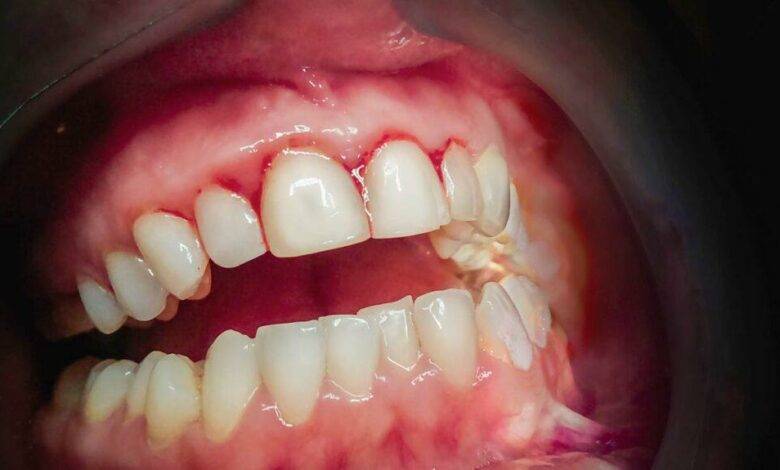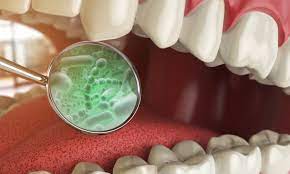Gingivitis Gums: What it is, Symptoms, Causes, treatment, and prevention

Gingivitis Gums: What it is, Symptoms, Causes, treatment, and prevention.
“Between 50% and 75% of all Americans have some form of gum disease.” That’s a pretty staggering number, isn’t it?
Gum disease is something that should be taken seriously.
This post will take a closer look at gum disease, its symptoms, causes, treatment, and prevention. Keep reading to learn more!
What is Gingivitis Gums?
 Gingivitis is a common gum disease that happens when tartar and plaque build-up along the gums.
Gingivitis is a common gum disease that happens when tartar and plaque build-up along the gums.
It starts with swelling of the gum tissue and, if not treated, can lead to more serious health problems like tooth decay, tooth loss, and periodontal disease.
Gingivitis is easy to treat and reverse before it causes more problems. All it takes is the right treatment and regular maintenance visits to the dentist.
Types of Gingivitis Gums:
There are two main types: dental plaque-induced gingivitis and non-plaque-induced gingival lesions.
Poor oral hygiene habits, like not brushing or flossing, cause too many bacteria in the mouth, which leads to gingivitis caused by dental plaque. It makes the gums look red and swell up, and they hurt and bleed when you brush your teeth.
Gingival lesions that aren’t caused by plaque are caused by systemic diseases like diabetes and HIV/AIDS, certain medications, or even changes in hormones caused by puberty or menopause.
Even though this form is painful, swollen, inflamed, and sometimes bleeds like the one caused by plaque, it does not get better when you clean your teeth better.
The Symptoms of Gingivitis Gums
The symptoms of gingivitis may vary from person to person, but typically, the symptoms of gingivitis include the following:
- Red, tender, swollen gums
- Mild bleeding gums when brushing or flossing
- Pain or sensitivity around the gums
- Gums that pull away from the teeth
- Bad breath (halitosis)
- People with gingivitis also experience recessed gum lines and visible gum inflammation around their teeth.
The causes of Gingivitis in Gums
There are several causes of gingivitis, including:
Poor oral hygiene
Brushing twice daily, flossing daily, and seeing your dental hygienist regularly for professional cleanings are important. When plaque is not removed in these ways, it accumulates around the gum line and between teeth, leading to gingivitis.
Smoking or chewing tobacco products

The chemicals in cigarettes and other tobacco products can weaken your gums and make them more susceptible to infection.
Medications that can contribute to Gum Disease
Certain medications that reduce saliva flow, such as those used to treat high blood pressure, depression, or allergies, can also contribute to gum disease.
Other risk factors that can increase your likelihood of developing gingivitis include the following:
- Hormonal changes such as pregnancy or menopause
- Diabetes.
- Genetic predisposition
- and even stress
Treatment for Gingivitis
There are several ways to treat gingivitis, depending on the severity of the dental health condition.
For mild cases, a good dental hygiene routine that includes brushing twice a day and flossing regularly may help relieve symptoms and reduce inflammation.
If this doesn’t help enough, it’s often best to talk to a dentist to figure out the best way to treat the problem.
Cleaning teeth and gums
Gingivitis can be an issue that needs to be addressed with dental intervention. To start, proper cleaning of the teeth is essential to managing any gum-related issues. Scaling and root planning are two ways to address the problem.
Scaling is a way to remove plaque build-up along the gum line that causes the gums to become infected. Root planning is a process used after scaling to smooth the root surface of the teeth and keep bacteria from accumulating between the tooth and gum tissue.
When gingivitis is more severe, lasers may be needed to remove diseased tissue and bacteria and stop the infection from spreading.
Gingivitis Medications
The treatment of gingivitis can involve a variety of medications.
Antiseptic mouthwash
It is a type of medication that may aid in the reduction of bacteria in the mouth, thereby preventing gum infection and bad breath.
Timed-release antiseptic chips
The antiseptic solution in these small discs dissolves over time, so they keep bacteria away for a long time.
Antibiotic microspheres
They have an effective dose of an antibiotic that kills bacteria and only goes to the gums to reduce swelling and pain.
Oral antibiotics, like Doxycycline, may be given for a short time to treat more serious problems when other solutions haven’t worked.
Gingivitis Gums: Surgery
Among the available treatments for gingivitis, surgery is often necessary.
Flap surgery
Flap surgery, which is also called “pocket reduction surgery,” removes diseased gum tissue and reshapes the healthy tissue over the tooth root to make the gum pockets around the tooth smaller.
Bone and tissue grafts
Bone and tissue grafts use bone from another part of the body to replace bone that has been destroyed by periodontal disease. This rebuilds areas that have been worn away and stabilises the bone structure that is already there. As with flaps, this eliminates deep pockets in which bacteria can accumulate.
Crown lengthening
Before putting on a new dental crown or bridge, crown lengthening involves cutting away gum tissue to expose more of the tooth’s surface. This can also be done to fix problems that are already there.
Each procedure helps get your jawbone back to how it was before gum disease, so you don’t lose more teeth or have other problems related to gum disease.
Gingivitis Gums: Prevention
Several steps can be taken to make sure you have good oral hygiene and keep gum disease from happening.
Regular brushing and flossing

The first step is regular brushing and flossing, which should be done at least twice daily and ideally after every meal or snack.
Dental check-ups
Regular dental check-ups should be set up so that any problems can be found and treated as soon as possible. Suppose a person notices gingivitis or gum problems such as swelling, redness, or bleeding. In that case, they should make an appointment with their dentist as soon as possible to take the necessary preventative action.
Diet and lifestyle adjustments
In addition to brushing your teeth and going to the dentist regularly, you may also want to make changes to your diet and how you live. Getting rid of sugary foods and drinks can help reduce plaque buildup, and exercise can help reduce stress. Activities like yoga can improve overall body health, which in turn helps with oral health.
Making these small changes now can create lasting results for gingivitis free & healthier gums in the future.
Associated health conditions with gum disease
Gum disease, or periodontal disease, is a serious condition that can lead to many other health concerns. The Centres for Disease Control and Prevention (CDC) and the National Institute of Dental and Craniofacial Research say that people with poor oral health are more likely to get diabetes, heart disease, stroke, and lung disease.
Researchers have found that inflammation caused by periodontal disease makes type 2 diabetes more likely to happen. People with diabetes are more likely to get heart disease because they have high cholesterol. Gum disease, which causes inflammation in the body, may make this risk even worse.
Also, research shows that people with gum diseases are more likely to have a stroke than those with healthy gums. For example, a report from the American Heart Association found that people with severe gum diseases were 19% more likely to have a stroke.
People with gum disease may be more likely to have breathing problems than people without gum disease. This is because the oral bacteria that cause gum disease often become airborne particles that get into the lungs. Individuals should ensure they receive proper periodontal care regularly to protect their overall health.
How a dental professional Diagnosed gingivitis gums?
A doctor diagnoses gingivitis of the gums through a detailed process. After a thorough medical history, the doctor will do an oral examination to check for inflammation and gum recession.
To figure out how bad the problem is, they might also measure the spaces between the teeth or use an x-ray to look for any problems below the gum line.
They may also take small samples of tissue or fluid from the affected area to help them decide. Once the doctor has all the information, he or she can figure out if gingivitis is present and make treatment suggestions based on that.
Gingivitis Gums: Summary
Gingivitis is a common gum disease that can be prevented or treated by taking care of your teeth, making changes to your diet and lifestyle, and going to the dentist regularly.
To protect your overall health, it’s important to keep an eye out for gum disease signs and symptoms and get treatment as soon as possible. If gum disease is caught early, people can avoid the other health problems it can cause and keep their gums healthy for many years.
Gingivitis FAQ:
What should I do if I have symptoms of gingivitis?
If you start to notice signs and symptoms of gum disease, like swollen or bleeding gums, you should see a dentist right away to stop the damage from getting worse. Your dentist can thoroughly evaluate and determine the best treatment for your condition.
How can I prevent gingivitis?
The best way to avoid getting gingivitis is to brush and floss your teeth every day as part of a regular oral hygiene routine.
Avoid sugary foods or drinks that contribute to plaque build-up and make lifestyle adjustments, such as exercising regularly or reducing stress.
Also, going to the dentist regularly is important so that any early signs of gum disease can be found and treated. With the proper care, you can help ensure long-lasting results for healthier gums.
Is there a cure for gingivitis?
Gingivitis is a condition that can be treated by taking care of your teeth and making changes to your lifestyle. However, it is important to note that gingivitis cannot be cured entirely.
The best way to keep gum disease at bay is by seeking professional dental care and following a regular oral hygiene routine. With the right care, you can make it less likely that your periodontal disease will lead to more problems.
Can brush too hard cause gingivitis?
Yes, brushing your teeth too hard can lead to gingivitis. According to the American Dental Association (ADA), it is best to use a soft-bristled toothbrush and gentle brush strokes when brushing your teeth. Plaque and bacteria can be removed from the teeth without hurting the gums by gently brushing in circles.



